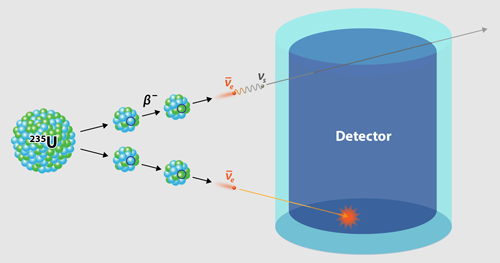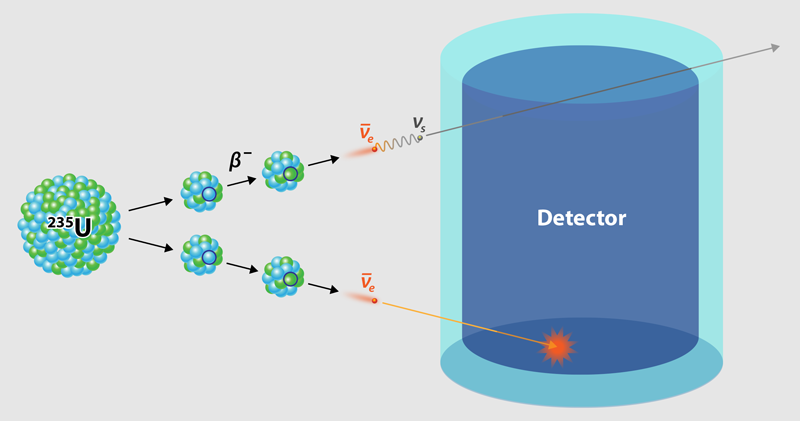Getting to the Bottom of an Antineutrino Anomaly
Neutrino physics is filled with questions. Is the neutrino its own antiparticle? How are the known mass states of neutrinos ordered from lightest to heaviest? Of late, researchers have even asked: How many neutrinos are there? In addition to the three known types of neutrinos—electron, muon, and tau—experiments in the last decade have hinted at the existence of one or more “sterile” neutrinos. The hypothetical particles could partially explain discrepancies between theoretical predictions and experiments involving neutrinos from radioactive sources, particle accelerators and, most recently, nuclear reactors [1]. Now, however, the collaboration behind the Daya Bay Reactor Neutrino Experiment in China has presented convincing evidence that links the reactor “anomaly” to uncertain theoretical models, not new particles [2]. While weakening the case for sterile neutrinos, the new finding also opens the door to improving these models, which could impact reactor safety and the monitoring of reactors for unauthorized nuclear weapon development.
Nuclear reactors are used worldwide for power production and basic research. The enormous heat provided by these reactors is generated by the fission of heavy isotopes, usually uranium or plutonium, which split into lighter nuclei after absorbing a reactor neutron. The resulting fission products are radioactive and undergo beta decay (Fig. 1). During this process, a neutron converts into a proton and emits an electron and an electron antineutrino, which share the energy released by the decaying nucleus. A typical reactor will emit about 1020 neutrinos per second.
The reactor anomaly first appeared in 2011 when a group re-calculated [3] the precise energy spectrum of antineutrinos emitted from the fission of 235U , 239Pu , 238U, and 241Pu. These calculations, which were confirmed the same year [4], predicted a significantly higher antineutrino flux than what experiments had detected. That is, antineutrinos seemed to be “missing” from experiments. When researchers re-evaluated parameters that affect the calculated flux, the deficit only became worse, amounting to 6%, or 3 times the uncertainty in the calculated spectrum.
Researchers have investigated several possible explanations for the anomaly. The most thrilling scenario is that reactor antineutrinos “oscillate” into one or more sterile neutrinos. These oscillations would deplete the apparent flux of antineutrinos because sterile neutrinos fly through a detector without creating any signal. The existence of sterile neutrinos would have a huge impact on particle physics and cosmology, as, for example, certain theories predict that these neutrinos are candidate dark matter particles. Experiments around the world have chased evidence for oscillations involving the hypothetical particles, but so far, all such searches have come up empty.
An alternative explanation that doesn’t involve any new particles is that the calculated spectrum is more uncertain than we thought. Typically, the antineutrino energy spectrum is derived from the easier-to-measure electron spectrum. The most accurate way to do this “conversion” is, however, also prohibitively complicated: one has to track and sum the energies of the electrons emitted in the beta decay of all of the hundreds of kinds of fission products and then use conservation of energy to determine the energies of the corresponding neutrinos. A more practical approach, and the one followed in the 2011 papers, is to use a model [5] to convert the total electron energy spectrum into the antineutrino energy spectrum. The basis for such conversions today is an electron spectrum that was measured at a research reactor in the late 1980s [5]. So, either an unintentional error in this underlying electron spectrum or in the conversion model [6] could explain why the calculated antineutrino flux doesn’t agree with the measured one.
The mystery deepened two years ago when Daya Bay and two other large reactor neutrino experiments, Double Chooz in France [7] and RENO in Korea [8], reported the detection of a “bump” in the measured antineutrino energy spectrum with respect to the calculated spectrum. Since then, theoretical and experimental work [9] has led to the consensus that the bump is not the result of neutrino oscillations but rather a sign that researchers need to know more about the processes that produce antineutrinos. The Daya Bay experiment points to ways of fixing these issues in theoretical modeling and resolving the reactor anomaly.
For 1230 days in the period between 2011 and 2015, the Daya Bay researchers measured antineutrinos emitted from six 2.9-thermal-gigawatt reactor cores, which were located either at Daya Bay or at the Ling Ao power plant in China. In each of the six reactors, the fuel composition evolves over time: the main source of fission, 235U, is depleted, while 239Pu builds up. Daya Bay’s powerful reactors and four massive detectors allowed the collaboration to measure a sufficiently large number of neutrinos that they could correlate the antineutrino flux and energy spectrum to the fraction of fission reactions that involved 239Pu versus 235U. By doing this, the collaboration was able to show that the deficit in detected antineutrinos compared to predictions [3, 4] depends on the relative fractions of 235U, 239Pu, 238U, and 241Pu in the reactor. Specifically, the researchers found that 235U fissions produced 7.8% fewer antineutrinos than predicted—enough of a discrepancy to explain by itself the entire antineutrino anomaly (Fig. 1). In contrast, the discrepancy dwindled to almost zero for 239Pu fissions. If sterile neutrino oscillations were behind the missing antineutrinos, the discrepancy shouldn’t depend on the isotope involved in the fission.
Daya Bay’s determination of the antineutrino flux from 239Pu has a relatively high uncertainty (6%) and further measurements are needed to improve it. Double Chooz [7], RENO [8], and highly enriched uranium research reactors should also seek to confirm that the “anomaly” arises mainly with antineutrinos emitted from the products of 235U fission.
However, to fully address the reactor anomaly, researchers will need to take the more accurate approach described above to calculating the antineutrino, that is, figuring out how the beta decay of each fission product contributes to the antineutrino spectrum. Thanks to an abundance of nuclear data [10], we are on the cusp of being able to predict the antineutrino spectrum directly, instead of using conversion models. Such predictions could be used in efforts to detect nuclear reactor misuse [11], as the antineutrino flux and energy depend on the reactor fuel composition. And the same nuclear data impact other problems such as reactor safety or fundamental nuclear physics [9, 12].
This research is published in Physical Review Letters.
References
- G. Mention, M. Fechner, Th. Lasserre, Th. A. Mueller, D. Lhuillier, M. Cribier, and A. Letourneau, “Reactor Antineutrino Anomaly,” Phys. Rev. D 83, 073006 (2011).
- F. P. An et al. (Daya Bay Collaboration), “Evolution of the Reactor Antineutrino Flux and Spectrum at Daya Bay,” Phys. Rev. Lett. 118, 251801 (2017).
- Th. A. Mueller et al., “Improved Predictions of Reactor Antineutrino Spectra,” Physical Review C 83, 054615 (2011).
- P. Huber, “Determination of Antineutrino Spectra from Nuclear Reactors,” Phys. Rev. C 84, 024617 (2011).
- A. A. Hahn et al., “Antineutrino Spectra from 241Pu and 239Pu Thermal Neutron Fission Products,” Phys. Lett. B 218, 365 (1989).
- A. C. Hayes, J. L. Friar, G. T. Garvey, G. Jungman, and G. Jonkmans, “Systematic Uncertainties in the Analysis of the Reactor Neutrino Anomaly,” Phys. Rev. Lett. 112, 202501 (2014).
- Y. Abe et al. (Double Chooz Collaboration), “Indication of Reactor ̄𝜈e Disappearance in the Double Chooz Experiment,” Phys. Rev. Lett. 108, 131801 (2012).
- J. K. Ahn et al. (RENO Collaboration), “Observation of Reactor Electron Antineutrinos Disappearance in the RENO Experiment,” Phys. Rev. Lett. 108, 191802 (2012).
- M. Fallot et al., “New Antineutrino Energy Spectra Predictions from the Summation of Beta Decay Branches of the Fission Products,” Phys. Rev. Lett. 109, 202504 (2012); A. A. Sonzogni, E. A. McCutchan, T. D. Johnson, and P. Dimitriou, “Effects of Fission Yield Data in the Calculation of Antineutrino Spectra for 235U (n, fission) at Thermal and Fast Neutron Energies,” Phys. Rev. Lett. 116, 132502 (2016).
- A.-A. Zakari-Issoufou et al., “Total Absorption Spectroscopy Study of 92Rb Decay: A Major Contributor to Reactor Antineutrino Spectrum Shape,” Phys. Rev. Lett. 115, 102503 (2015).
- M. Fallot et al., “The Detection of Reactor Antineutrinos for Reactor Core Monitoring: an Overview,” Nucl. Data Sheets 120, 137 (2014).
- P. Dimitriou and A. L. Nichols, IAEA Report No. INDC(NDS)-0676 (2016); A. Algora et al., “Reactor Decay Heat in 239Pu: Solving the 𝛾 Discrepancy in the 4–3000-s Cooling Period,” Phys. Rev. Lett. 105, 202501 (2010).





